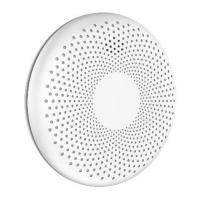and be certain a safe condition exists. If the source is unknown, it should be assumed
that the alarm is due to dangerous levels of carbon monoxide.
Maintenance and cleaning
There are a few simple steps you need do to keep it working properly:
• Test the detector once a month.
• Do not paint the detector. Paint will seal the vents and interfere with the sensors.
• Never attempt to disassemble the detector to clean inside. This will damage the alarm.
• Clean the detector at least once a month to remove dust, dirt or debris. Use a vacuum
cleaner with a soft brush and vacuum all sides and covers of the detector.
Some materials, vapours or gases, can affect the reliability of the alarms in the short or
long term. The following is a list of substances that at high levels can damage the sensor or
cause temporary readings that are not CO readings: Ethylene, ethanol, alcohol, iso-
propanol, benzene, toluene, ethylacetate, hydrogen, hydrogen sulfide and sulfur dioxide.
Also most aerosol sprays, alcohol based products, paint, thinner, solvent, adhesive, hair
spray, after shave, perfume, auto exhaust (cold start) and some cleaning agents.
LED indicators

